Abstract
The remains of “early” mammoths from a number of localities of the late Middle—early Late Pleistocene on the territory of the South of European Russia (the basin of the Don River, Rostov Region) are described. The description of the teeth and bones of a postcranial skeleton is given. Teeth characteristics (number of plates, lamellar frequency and enamel thickness) allow determining the finds as Mammuthus intermedius, described from the territory of France but known from other regions of Western Europe and Western Siberia as well. In Eastern Europe, this form was a typical representative of the Khazarian theriocomplex and existed during the MIS 5–7 interval. This mammoth taxon differs noticeably from the typical woolly mammoth M. primigenius, which appeared in continental Europe during MIS 4.
1. Introduction
The representatives of the Mammuthus genus are typical of the Middle and the Late Pleistocene communities of Northern Eurasia. However, the data on mammoths are unevenly distributed geographically and chronologically. In particular, there are descriptions only of a small number of finds of the late Middle Pleistocene—Late Pleistocene Mammuthus from the steppe zone territory of the South of European Russia. The current paper contains a revision of the materials from several museums of the Rostov Region (Russia). They allow providing a regional overview of the data on mammoths of the indicated period and comparing them with the ones from the Pleistocene of Northern Eurasia.
This paper also considers the issue of the systematic position of the so-called ‘early” type or “primitive” form of woolly mammoths. Some researchers are of the opinion that broad ranges of intra-specific and geographical variability do not allow to distinguish the intermediate taxa of mammoths. For example, only two taxa are indicated for the elephants of the mammoth line existing on the territory of Eurasia during the Middle—Late Pleistocene: Mammuthus trogontherii and M. primigenius [1,2,3]. However, there is another point of view, based on the recognition of more distinct taxa of the Pleistocene mammoths at the species and subspecies levels. Such an approach provides a possibility to thoroughly consider evolutionary changes in the phyletic lines of the mammoth due to climatic and paleoenvironmental fluctuations and to determine the time and ways of their distributions [4]. Details of the evolutionary stages within the genus Mammuthus (one of the most thoroughly studied groups of the Pleistocene large mammals) allowed to describe several subspecies taxa of trogontherian mammoths, such as Mammuthus trogontherii trogontherii (Pohlig, 1885), M. trogontherii wuesti (Pavlow, 1910) and M. trogontherii chosaricus Dubrovo, 1966 [5,6,7]. Several subspecies of woolly mammoths [8,9,10,11] were also singled out. Considering the climatic fluctuations in the Late Pleistocene, the suggestion was made that it is necessary to distinguish thin- and thick-enamel varieties of mammoths accustomed to different vegetation types during warm and cold periods [12].
One such “intermediate” taxon is Mammuthus intermedius (Jourdan, 1861), described based on the finds from Western Europe (Rhône River Valley, France) as Elephas intermedius [13,14]. This form is morphologically and metrically intermediate in dental characteristics along the mammoth line between M. trogontherii (Pohlig, 1885) and M. primigenius (Blumenbach, 1799). The validity of M. intermedius was later doubted [1]. Later on, it was resurrected with a diagnosis and designation of a lectotype and paratypes [15,16]. Remains of these mammoths are reported from the territory of Moldova [17], the Lower Volga Region [18], and the South of Central Siberia and Western Siberia [19]. V.S. Baigusheva [20] described the specific features of the remains of woolly mammoths from a locality near Kamensk (left bank of the Severskiy Donets River, Rostov Region, Russia) and indicated that the considered form differed from typical “late” mammoths and was intermediate between Mammuthus chosaricus and M. primigenius. According to her opinion [20,21], some teeth characteristics allowed to single out the late Middle Pleistocene thick-enamel form of “early” mammoth as a separate taxon (subspecies) within M. primigenius. Morphologically similar finds of the same geological age related to such mammoths are also known from the Volga Region [18,22] and the lower areas of the Severskiy Donets River [23]. According to I.V. Foronova [19], M. intermedius was typical of the interglacial periods of the second half of the Middle Pleistocene. We also agree that M. intermedius is an independent taxon, clearly distinguished by dental characteristics from other representatives of the genus Mammuthus. We think that the use of formal taxa for these intermediate forms allows to avoid the usage of informal taxonomic forms, such as “early/primitive” and “late” types/forms of woolly mammoths. This mammoth was a typical representative of the faunas of Europe and Western Siberia in the second half of the Middle Pleistocene and the early Late Pleistocene. In Eastern Europe, it is an element of the Khazarian theriocomplex (correlated with the faunal stages of Torre in Pietra, Vitinia and Melpignano of Italy; MNQ 24 and 25 zones), the age of which falls into the Marine isotope stages (MIS) 7–5 range [18,24].
In spite of a relatively good surveying of the region, the finds of M. primigenius on the territory in the South of Eastern Europe are rather rare and are often related to the localities situated in the foothills of the Caucasus, Crimea, and the Carpathians [25,26]. This is probably because arid steppe ecosystems of the open landscapes of Eastern Europe were not sufficiently productive for these large animals.
Characteristics of the localities. The described mammoth remains come from different types of deposits and different areas of the basin of the Lower Don River and its tributaries (Figure 1). Since many specimens were discovered rather long ago, it is not always possible to restore their exact stratigraphic positions and determine their geological ages.
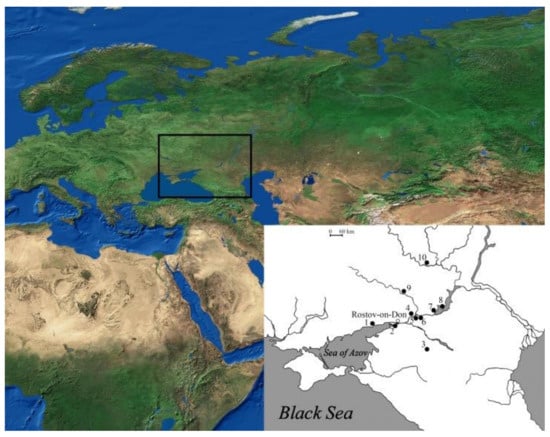
Figure 1.
The localities of Mammuthus intermedius remains in the Lower Don Region (Russia). 1—Beglitsa, 2—Elizavetinskaya, 3—Peschanokopskoe, 4—Razdorskoe, 5—Semikorakorsk, 6—Novozolotovskaya, 7—Tsymlyansk, 8—Nizhne-Kurmoyarskaya, 9—Kamensk-Shakhtinskiy and 10—Vyoshenskaya.
Kamensk-Shakhtinskiy. The remains of several mammoths came from a sand pit on the left bank of the Severskiy Donets River near the town of Kamensk-Shakhtinskiy in the Rostov Region. The remains were discovered in 1927–1929 by an employee of the Museum of Novocherkassk, L.A. Abaza. Flint tools of the Mousterian type, discovered in this quarry, allowed specifying the geological age of the deposits [27]. Bone remains of Bison sp. and Equus sp. were also collected in the sand pit. According to the preliminary data by Professor P.N. Chervinsky, the remains of six individuals of mammoths were discovered in the quarry. According to our data, eight large tibias were paired by size and the degree of epiphyseal fusion, thus allowing to determine a minimum number of four specimens. The collection remained unstudied for a long time, was stored at the Novocherkassk Museum of History of the Don Cossacks and was described only in 1980 [20]. Based on their preservation degree, we supposed that all the remains of the mammoths were of the same geological age. The bones were recovered as isolated skeletal elements, not articulated. The finds were not associated with the ancient human site. The fossils lay at a depth of almost seven m from the surface. The finds, discovered in situ, related to a thin greyish interlayer of a grey-green color and were almost 20-cm-thick in the thickness of the horizontal- and cross-bedded sands. A layer of loam with a developed thick humus layer overlaid a heavy layer of sand [27]. In the filling of the mammoth’s mandible, a few palynomorphs—some grains of pine Pinus sylvestris and dinocysts Operculodinium centrocarpum (determination by A.N. Simakova, 2018, GIN RAS)—were determined. As there are no exposed deposits in the area of the find’s discovery, the registration of cysts of the indicated dinoflagellates species in the deposits was not connected with the dissolution of such layers. The occurrence of O. centrocarpum, which is an indicator of the Atlantic water masses’ distribution within the Arctic shelf of Eurasia, possibly relates to the Karangatian transgression of the Black Sea, which correlates with the Mikulian (Eemian) interglaciation.
Beglitsa. The stratigraphic section is located 20 km to the west of Taganrog. The coastal cliff exposes up to a 15-m-thick sequence of lagoonal clays and silts overlain by thin loess–paleosol deposits that include the Mezin paleosol complex (Eemian), the Bryansk and the Trubchevsk Upper Pleistocene paleosols [28,29]. The base of the 16–18-m section exposes a loam sandy layer (apparent thickness up to two m), which is interpreted as lagoon–liman or liman–marine and alluvial–diluvial deposits [29,30,31]. The remains of freshwater mollusks small and large mammals are registered in this layer. Considering the bio-stratigraphic data, including palynological, it is supposed that the formation of fossiliferous thickness began in the late Odintsovo/Gorky/Kamensk interglaciation (MIS 7) and continued during a considerable part of the Moscow glaciation period (MIS 6). Scattered finds of Castor fiber, Lagurus lagurus, Ursus (Spelearctos) savini rossicus, Equus sp., Megaloceros sp. and Cervus sp. were discovered in this layer as well. In 1998, private collectors discovered a fragment of a mammoth’s skull with two M3 teeth in the basement of the cliff. Only one of these molars was available for our studies.
Peschanokopskoe. An incomplete skeleton of a mammoth was discovered in 1998, 16 km to the southeast of the village of Peschanokopskoe (Rostov Region) on the bank of the Rassypnaya River (the Egorlyk River’s tributary) near the settlement of Rassypnoe. Unfortunately, the skeleton was destroyed by the local people. Some bones became part of the collections of the Rostov Regional Studies Museum and Azov Museum-Reserve. The find related to a sandy loam layer in the lower part of the first above floodplain terrace of approximately 2.7 m high. The stratigraphic location of the find indicates its Late Pleistocene age [32].
Vyoshenskaya. The Vyoshenskaya locality is in the 40–45-m high coastal cliff on the left bank of the Don River near the stanitsa of Vyoshenskaya (Rostov Region). The lower bed is at the base of the 10–12-m-thick fluviatile member, at the boundary with the underlying basal-layered brownish-gray clay. This clay bed contains shells of freshwater mollusks. The lower fluviatile member is represented by cross-bedded white quartz sand with interbeds of gravel and clay. This level produces the highest number of large and small vertebrate bones. The revised faunal list contains Sorex sp., Castor fiber, Spermophilus sp., Cricetus cf. cricetus, Lagurus lagurus, Microtus arvalis, Microtus agrestis, Microtus gregalis, Microtus oeconomus, Microtus sp., Arvicola chosaricus, Clethrionomys glareolus, Mustela nivalis, Canis lupus lunellensis, Vulpes sp., Ursus (Spelearctos) savini rossicus, Leo spelaea, Equus cf. latipes, Equus hydruntinus, Coelodonta sp., Cervus cf. elaphus, Megaloceros giganteus, Alces sp., Bison priscus and Saiga cf. tatarica. It is likely correlative to the transition from the interstadial to glacial climatic phase of the late Middle Pleistocene [33]. The described finds of mammoths were discovered by Baigusheva and D.N. Nikonov in the 1970s.
Tsymlyansk. An incomplete mandible with a left lower m3 was discovered by V.S. Baigusheva and V.P. Litvinenko in 1972 in the bed of covering loam northeast of the town of Tsymlyansk (Rostov Region) in the coastal cliff of the Tsimlyansk Water Storage Reservoir. Loess soil horizons were revealed in the upper part of the coastal outcrops, which reached 20-m-high in this area. A fragment of one more isolated tooth was discovered in 2006 during the expedition by one of the authors under the cross-section on the shore of the Tsymlyansk Water Storage Reservoir two km to the northeast of the settlement of Sarkel. The age range of these loams is broadly determined as the late Middle—Late Pleistocene [34].
The Don River fluvial deposits. The finds of mammoth remains from the fluvial deposits are discovered in the Lower Don Region periodically. Limb bones, jaws and isolated teeth get in the fishing nets from the river bottom, are thrown ashore when conducting dredging or discovered in sand pits with washed sand in the lower reaches of the Don River. Such finds are frequent; rather, many of them have been accumulated during the 20th and the early 21st centuries. The materials are stored within the collections of the Rostov Regional Studies Museum, Novocherkassk Museum of History of the Don Cossacks, Azov Museum-Reserve, Aksai Museum and other regional and local museums. In particular, fragments of skulls, jaws, isolated teeth and bones of postcranial skeletons were registered in the area of the town of Semikorakorsk, stanitsas of Nizhne-Kurmoyarskaya, Razdorskaya, Novozolotovskaya, Elizavetinskaya, settlement of Kagalnik, etc. (Rostov Region). Apart from mammoth remains from fluvial deposits, there are also bones of other representatives of the Khazarian faunal complex: Equus sp., Camelus knoblochi, Megaloceros gigantheus and Bison priscus [35].
2. Materials and Methods
The measurements and the main characteristics of elephants’ teeth were taken according to traditionally applied methods [36,37,38]. The sizes of a crown (length, width and height); lamellar frequency and enamel’s thickness were analyzed. Lamellar frequency per 10 cm was measured perpendicular to the direction of the plates at the midpoint of the crown height. In order to avoid errors due to the curvature of the crown, measurements were taken, if possible, in two or three places of the crown (anterior, middle and posterior) on each side. The measurement results were summed up, and the arithmetic mean was calculated [38]. The evolutionary important parameter, the hypsodonty index (ratio of the height to the width of a crown), was calculated for weakly and medium-worn teeth that preserved unworn plates [39]. Wear stage of teeth was determined by the number of worn plates [38]: the crown was not affected by wear—0, the crown was slightly worn—1, about less than half of the total number of plates was worn—2, half of the number of plates was worn—3, more than half of the plate was worn—4, all plates were affected by wear—5 and only part of the crown remained due to considerable wear—6. Talons and talonids are incomplete enamel plates, located in the anterior and posterior parts of a crown and which do not have corresponding roots. In tooth formula, they are indicated with the letter “t”. Some authors use the term “platelet” for their identification. To simplify the comparison of the described materials with the data by various authors, we indicated the number of complete plates without the talons. The upper molars were indicated with the capital letter “M” and the lower ones—with “m”. In cases when the anterior part of a crown was damaged/worn, we calculated the number of plates, taking into account the presence of additional four plates on the anterior main root of the tooth (without a talon) [40]. To designate the most characteristic wear figures on the occlusal surface of trinomial slightly worn plates in ancient elephants/mammoths, their schematic graphic designation was used [36]. Rounded wear shapes are indicated as dot a • and oval ones as a dash –.
We used electronic hand calipers for the measurements. The diagram plotting was carried out using Statistica software (StatSoft. Inc. (2007) STATISTICA, version 8.0, www.ststsoft.com) and the Adobe Photoshop editor.
Mostly the teeth are described here. From the Kamensk-Shakhtinskiy locality, however, the bones of a postcranial skeleton are briefly characterized due to their good preservation state.
Kamensk-Shakhtinskiy. Upper M3 (NMDC; Pal-19, 59 and 91) and lower m3 (Pal-85 and 100) teeth; atlas (Pal-35); epistropheus (Pal-36); the fourth cervical vertebra (Pal-41); thoracic vertebrae (Pal-20, 21, 37 and 40); lumbar vertebrae (Pal-22, 38, 39 and 42); sacrum (Pal-33); rib (Pal-242); scapula (Pal-211); humeri (Pal-58, 59, 60, 61, 68, 220 and 226); ulnae (Pal-184, 210, 213, 214 and 219); radii (Pal-173); pelvic bones (Pal-204 and 207); femora (Pal-57) and tibiae (Pal-185, 186, 187, 188, 189, 190, 191 and 192). The colour of bones is light-creamy on the surface and at the fracture. Bones are weakly mineralized and slightly rounded. The teeth have light-grey enamel and light-creamy dentine. The total number of finds is 61 (Figure 2, Figure 3, Figure 4). Collection of NMDC.
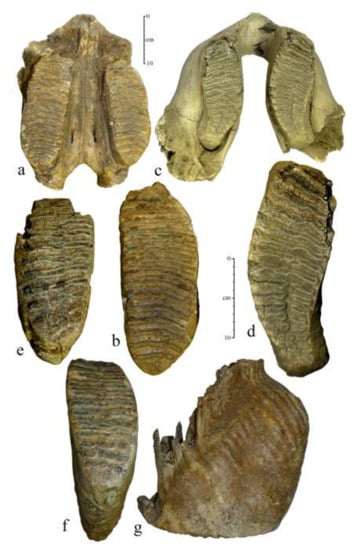
Figure 2.
The teeth of mammoth Mammuthus intermedius from Kamensk-Shakhtinskiy (Rostov Region, Russia), the late Middle Pleistocene: (a)—NMDC No. Pal-59, fragment of skull with M3s, ventral view, (b)—NMDC No. Pal-59, left M3, occlusal surface, (c)—NMDC No. Pal-85, lower jaw, dorsal view, (d)—NMDC No. Pal-85, right m3, occlusal surface, (e)—NMDC No. Pal-91, right M3, occlusal surface and (f,g)—NMDC No. Pal-19 left M3, occlusal surface, buccal view.
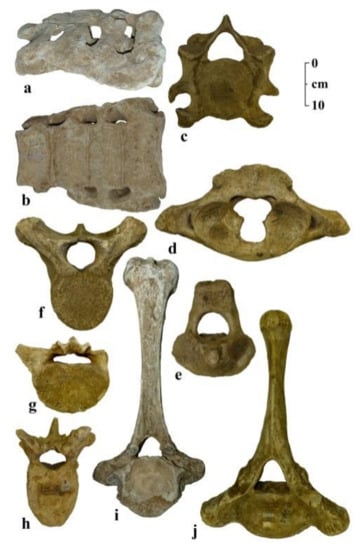
Figure 3.
Isolated vertebra of mammoth Mammuthus intermedius from Kamensk-Shakhtinskiy (Rostov Region, Russia), the late Middle Pleistocene: (a,b)—NMDC No. Pal-33, sacrum, lateral right view, ventral view, (c)—NMDC No. Pal-41, fourth cervical vertebra, anterior view, (d)—NMDC No. Pal-35, first cervical vertebra, anterior view, (e)—NMDC No. Pal-36, second cervical vertebra, anterior view, (f)—NMDC No. Pal-37, thoracic vertebra, anterior view, (g)—NMDC No. Pal-39, lumbar vertebra, posterior view, (h)—NMDC No. Pal-38, lumbar vertebra, anterior view, (i)—NMDC No. Pal-21, thoracic vertebra, posterior view and (j)—NMDC No. Pal-40, thoracic vertebra, anterior view.
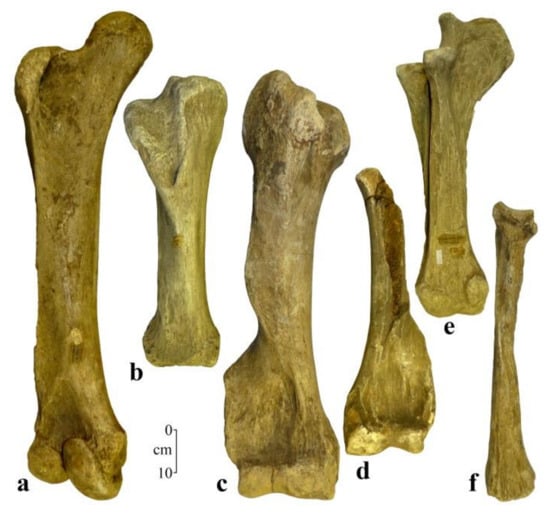
Figure 4.
Long bones of post-cranial skeleton of Mammuthus intermedius from Kamensk-Shakhtinskiy (the early Late Pleistocene; Rostov Region, Russia): (a)—NMDC No. Pal-57, left femur, posterior view, (b)—NMDC No. Pal-189, right tibia, anterior view, (c)—NMDC No. Pal-61, right humerus, anterior view, (d)—NMDC No. Pal-59, incomplete left humerus, anterior view, (e)—NMDC No. Pal-213, left ulna, lateral view and (f)—NMDC No. Pal-173, right radius, medial view.
Beglitsa. Isolated upper-right M3 (Figure 5). Color of the dentine is light creamy, and color of the enamel is —white. Private collection of A.S. Basan, Taganrog (Russia).
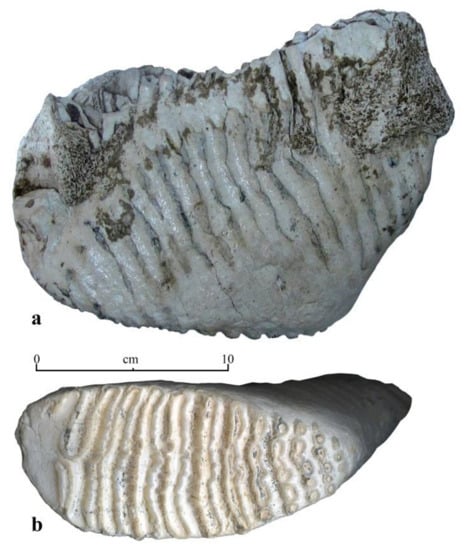
Figure 5.
Tooth of mammoth Mammuthus intermedius from Beglitsa (Rostov Region, Russia; the late Middle Pleistocene): (a,b)—private collection, right M3, lingual view, occlusal surface.
Peschanokopskoe. An isolated upper heavily worn left M3; collection of ROMK. A fragment of a mandible with a heavily worn right m3; collection of ROMK. A lower left heavily worn m3 with a fragment of a mandible; collection of AMZ. All finds belong to one individual (Figure 6). The color of the dentine is light-creamy, and the color of the enamel is white.
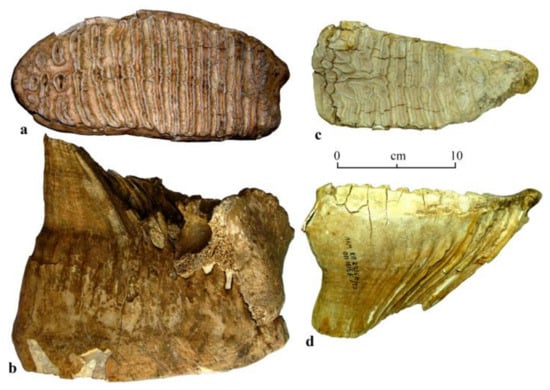
Figure 6.
Tooth of mammoth Mammuthus intermedius from Peschanokopskoe (Rostov Region, Russia; the early Late Pleistocene): (a,b)—ROMK no No., left M3, occlusal surface, lingual view and (c,d)—AMZ KP-27350/1, left m3, occlusal surface, lingual view.
Vyoshenskaya. A fragment of the right mandibular corpus with heavily worn incomplete m1 and slightly worn m2 lacking the posterior part of a crown. A posterior root of the previous m1 is preserved in the mandible. Collection of ROMK. The m1 of the specimen and a posterior part of m2 are lost. The color of the bone is grey-brown, the color of the dentine is grey-brown and the enamel is light-grey.
Tsymlyansk. An isolated left-lower m3 (Figure 7). The anterior talon and the first plate are damaged; the posterior talon on the incompletely formed back part of a crown is absent. The color of the dentine is light-brown; the enamel is light-grey. Collection of AMZ.
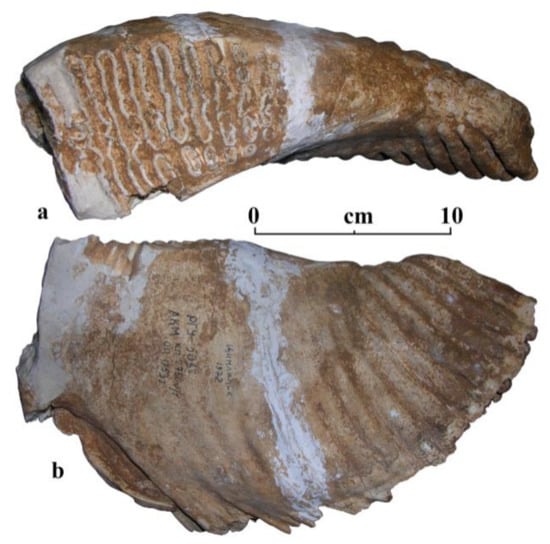
Figure 7.
Tooth of mammoth Mammuthus intermedius from Tsymlyansk (Rostov Region, Russia; the late Middle—early Late Pleistocene): (a,b)—AMZ KP-27500/1, left m3, occlusal surface, buccal view.
The Lower Don River fluvial deposits. Isolated upper M3 and lower m2 from the collection of NMDC. An isolated lower m2 from the collection of AVIM. An isolated heavily worn left m3 from the collection of ROMK. The color of the dentine is from light- to dark-brown, and the enamel is grey.
3. Results
Family Elephantidae Gray, 1821
Tribe Mammuthini Osborn, 1921
Genus Mammuthus Burnett, 1830
Mammuthus intermedius (Jourdan, 1861)
Description. A separate description of the specimens from different localities is given.
Kamensk-Shakhtinskiy. Longitudinal axes of the upper jaw teeth insignificantly diverge backward at the angle of around 15%. The front edge of the choanal notch of the bone palate is at the level of the back edge of M3. Well-defined are oblong large palatal foramens (Foramen palatinum majus) at the level of the posterior third of M3. A relatively short and massive corpus characterizes the mandible. The mental process is not massive. The mammoth teeth in the collection are medium and heavily worn (Figure 2). The number of enamel plates in the upper teeth is 23 to 24, without taking into account the anterior and posterior talons. The lower teeth, being considerably worn, do not allow to estimate the complete number of plates. The lamellar frequency of the upper teeth is 7.2–(7.62)–7.9 and, of the lower ones, 6.9–(7.0)–7.1 (Table 1). The enamel on the occlusal surface is weakly folded. Its thickness on the teeth of the last generation ranges from 1.8 to 2.4 mm and, on average, 2.1 mm. The hypsodonty index for two upper medium-worn teeth was 1.74–1.77. The wear figures on the occlusal surface of the trinomial plates of the intermediate type consist of three relatively conformed ovals (– – –).

Table 1.
Measurements of M3 and m3 of Mammuthus intermedius from Kamensk-Shakhtinskiy (early Late Pleistocene; Rostov Region, Russia). ~—worn plates, –—damaged plates and 20 —restored plates.
The first cervical vertebra, atlas, has large sizes. The crest of a single atlas is well-defined, has a rough surface and is longitudinally located low on the spine (Figure 3d). The outer edges of the crest overhang the lateral spinal foramens. The transverse foramens are large, around 18 mm. The surface for the occipital condyles of the skull is slightly concave in the transverse direction. The height of the spinal canal of the vertebra (102 mm) is larger than its maximum width (85 mm).
The second cervical vertebra is epistropheus. The vertebra has a fractured upper arch, and both its transverse processes are fractured (Figure 3e). The posterior epiphysis is not fully fused. The width and height of the spinal canal are 76 × 68 mm, correspondingly. The width of the joint surface for the atlas is 193.2 mm and, for the third cervical vertebra, 138 mm.
The third or the fourth cervical vertebra. There is a slightly fractured spinous/spinal process at the top, and the arches of the inter-transversal foramens are damaged. The ventral part and edges of the posterior epiphysis are damaged. The anterior epiphysis is fused. The width of vertebra in the area of transversal processes is around 265 mm, in the area of articular processes is 216 mm, the width of the anterior articular surface of the vertebra’s body is 133 mm, the height is 140 mm, the width of the posterior articular surface of the body is 151 mm and the height is 142 mm. The width of the spinal canal is 88 mm. The length of the body below is 38 mm and, above, 20 mm.
Thoracic vertebrae. The mostly well-preserved vertebra is NMDC No. Pal-40—the length of the spinous process from the spinal canal is 365 mm, and the width and diameter of the upper part of spinous process is 74 × 92 mm (Figure 3j). The width of the vertebra in the area of the transverse processes is 312 mm, and the width of the anterior epiphysis is 150 mm. The ventral length of the vertebra body is 57, and the dorsal length is 50 mm.
The lumbar vertebrae. The width of the vertebrae in the area of the transverse processes is measured by the half of the specimens: NMDC No. Pal-38: 100.4 × 2 = 200.8 mm and, in the case of NMDC No. Pal-39, 132 × 2 = 264 mm (Figure 3g,h). The width of the spinal canal of Pal-38: 57 mm and, of Pal-39 (probably the last lumbar): 101 mm; the height of spinal canal is, correspondingly, 41 and 23.8 mm, and the width of the posterior epiphysis is 104 and 143 mm. The ventral length of the body (Pal-38) is 71 mm, and the dorsal one is 75 mm.
The sacrum is represented by four fused-together vertebrae (Figure 3a,b). Caudally, there is a trace of the next, not fused, vertebra. The length (incomplete) of the sacrum, measured on the ventral side, is 290 mm, the width of the anterior epiphysis is 177 mm, the width of spinal canal cranially is 68 mm and, caudally, is 45 mm.
Humerus. The collection includes bones of different individual ages (Figure 4c,d). Four bones have unfused proximal epiphyses (Table 2). The maximum length of the only complete bone of NMDC No. Pal-61 is 990 mm. The bone is slender; the ratio of the minimum width of diaphysis to the length of the bone of the specimen of Pal-61 is 13.3. The lateral epicondyle of a distal trochlea is low; its height in the case of P-61 is 285 mm. The width in the area of the epiphyseal suture in various finds varies from 230 to 290 mm (on average for six specimens, 269 mm).

Table 2.
Measurements of humerus of Mammuthus intermedius from Kamensk-Shakhtinskiy (the early Late Pleistocene; Rostov Region, Russia). Data in brackets are approximates.
Ulna. The collection includes four ulnar bones (Table 3). The bones are straight, with subtriangular cross-sections in the proximal part. The olecranon is short and massive (Figure 4e). A short processus anconeus slightly overhangs the semilunar notch. The ratio of the minimum width of the diaphysis to the length of the bone, on average, is 12.39 (Table 3).

Table 3.
Measurements of the ulna of Mammuthus intermedius from Kamensk-Shakhtinskiy (the early Late Pleistocene; Rostov Region, Russia).
Radius. A slender bone without unfused distal epiphysis and notably curved diaphysis (Figure 4f). There is a well-defined sharpened crest on the back surface of the diaphysis, and the length is more than half a bone. The maximum length of the specimen to the distal epiphyseal suture is 600 mm. The width of the proximal end is 105 mm. The minimum width of a diaphysis is 60 mm. The width of the distal end at the level of epiphyseal suture is 150 mm.
Femur. The single femur is well-preserved (Figure 4a and Table 4). The neck of the femoral head is short, directed at the angle of around 30° to the longitudinal axis of the bone. The greater trochanter of the proximal end of the bone is weakly developed and is located lower than the base of the head. The ratio of the thickness of a diaphysis to the length of the bone is 13.1.

Table 4.
Measurements of the femur of Mammuthus intermedius from Kamensk-Shakhtinskiy (the early Late Pleistocene; Rostov Region, Russia).
Tibia. The collection contains eight tibiae of a minimum of four individuals with a different degree of epiphyseal fusion. The cross-section of the bone is subtriangular. The crest (crista tibiae) is well-developed (Figure 4b and Table 5). The medial articular surface of the proximal epiphysis is a wide oval with a transverse long axis. The lateral articular surface is smaller by the total area and has a sub-rectangular form. The crest, dividing these condyles, is not high. The ratio of the diaphysis width to the bone’s length, on average, is 17.3.

Table 5.
Measurements of the tibiae of Mammuthus intermedius from Kamensk-Shakhtinskiy (the early Late Pleistocene; Rostov Region, Russia).
Beglitsa. A medium-worn M3 consists of 21 complete plates, excluding the anterior and posterior talons (Figure 5 and Table 6). The lamellar frequency in different parts of the crown varies from 7.75 to 9.0 and, on average, is 8.8. The thickness of the weakly folded enamel varies within 1.2–2.4 mm (1.75 mm on average). The hypsodonty index is 1.74. The wear figure on the occlusal surface of the trinomial plates is of an intermediate type (– – –).

Table 6.
Measurements of Mammuthus intermedius teeth from different localities of the Lower Don Region (Southern Russia). t—talon, ~—worn plates, –—damaged plates and 20 —restored plates, superscript (for example, 13) – the number of measured plate.
Peschanokopskoe. The mandibular corpus is short and massive. The damage of the jaw does not allow to restore the size of the mental process. All M3/m3 teeth are heavily worn, but the wear stage of the lower ones is greater (Figure 6 and Table 6). The lamellar frequency is 7.0–7.5. We may suppose that the same index in the lesser-worn teeth was a bit higher. The enamel’s thickness varies from 1.6 to 2.2 mm (on average, 1.8 mm).
Vyoshenskaya. All teeth studied in different years are more or less damaged. No teeth of the last generation were discovered. The lamellar frequency in various parts of the crowns of m1 and m2 varies from 7.5 to 8.5 (8.0, on average). The thickness of the weakly folded enamel varies from 1.2 to 2.2 mm (2.1 mm, on average).
Tsymlyansk. A fragment of the upper M1–2 tooth has a lamellar frequency of 7.75 and an average enamel’s thickness of 2.1 mm. The hypsodonty index of the tooth is 1.78. The incompleteness of the find does not allow to determine its complete characters. The lamellar frequency for a medium-worn m3 is 8.0 on average, and the thickness of the weakly folded enamel is 1.7 (Figure 7 and Table 6). The restored number of plates is 21 without taking into account the anterior and posterior talons. The hypsodonty index is 1.95. The wear figure on the occlusal surface of the trinomial plates is of the intermediate type (– – –).
The Don River fluvial deposits. The teeth are usually isolated, with various degrees of roundedness. The mean lamellar frequency on weakly and medium-worn teeth varies from 7 to 8 but can reach the value of 6 on heavily worn teeth (Figure 8). The hypsodonty index for one of the studied teeth is 1.45 (Table 6). The mean thickness of the averagely folded enamel of the teeth of the last generation is from 1.8 to 2.2 mm and, of m2, 1.7 mm. The wear figure of enamel plates on the occlusal surface is analogous to the previously described finds.
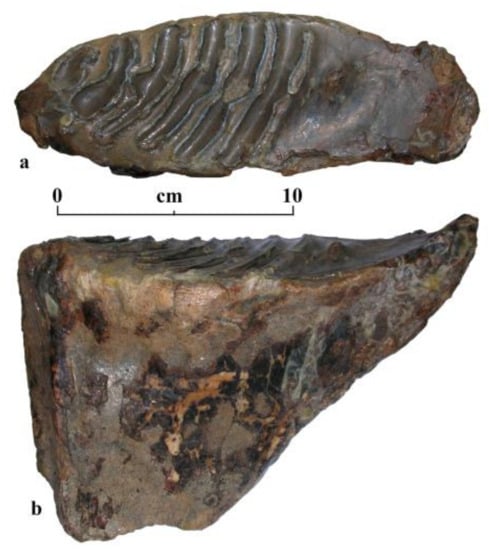
Figure 8.
Tooth of mammoth Mammuthus intermedius from Razdorskoe (Rostov Region, Russia; the late Middle—early Late Pleistocene): (a,b)—ROMK, no No., left m3, occlusal surface, lingual view.
4. Comparison and Discussion
The remains of mammoths from various localities of the Lower Don Region described in the current paper exhibit similar dental morphology. Their most significant parameters are the number of plates: 21–24 (excluding the anterior and posterior talons) in the teeth of the last generation and 16–18 on M2, as well as the lamellar frequency, 6.7–8.8 (6.0–7.5 on the heavily worn teeth). The length of a single plate was 11.0–15.7 mm. Weakly folded enamel with a mean thickness of 1.7–2.2 mm was typical of the studied teeth. The hypsodonty index varied from 1.45 to 1.78 in the upper teeth and reached 1.95 in the lower ones.
The teeth of the described mammoths from Southern Russia differ from the typical early Middle Pleistocene (Cromerian) M. trogontherii (Pohlig, 1885) from Süssenborn (Germany), Tiraspol (Transnistria) and the Kagal’nik sand pit (the Northeastern Sea of Azov Region, Russia) by the smaller (on average) size of a crown, thinner enamel, higher lamellar frequency, shorter length of a single plate and a larger number of plates (Figure 9, Figure 10, Figure 11) [41,42]. The syntype of M. trogontherii (Coll. Senckenberg Research Institute and Natural History Museum, Weimar, Germany, No. 3153/2057, m3, medium-worn, fourth stage of wear), which was associated with the lectotype of this species, has the lamellar frequency of 6.3 and enamel thickness of 2.1 [41,43,44].
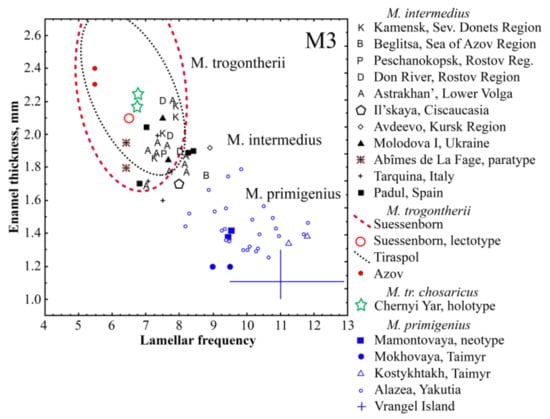
Figure 9.
Ratio of the lamellar frequency and enamel thickness on the upper M3 of Mammuthus intermedius from the Lower Don region compared to the other representatives of the genus Mammuthus. Measurements from [6,9,11,15,16,18,19,25,26,41,44,45,46,47,48,49,50] and our own data.
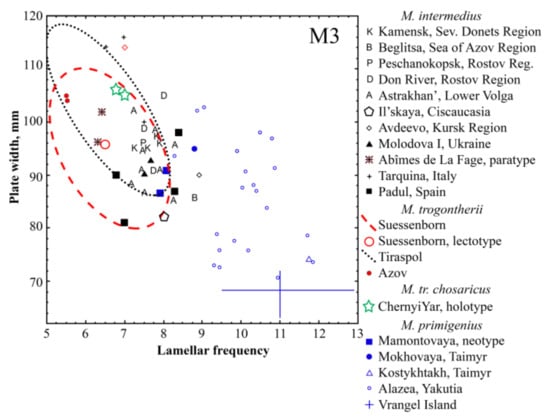
Figure 10.
Ratio of the lamellar frequency and the width of the enamel plates on the upper M3 of Mammuthus intermedius from the Lower Don region compared to the other representatives of the genus Mammuthus.
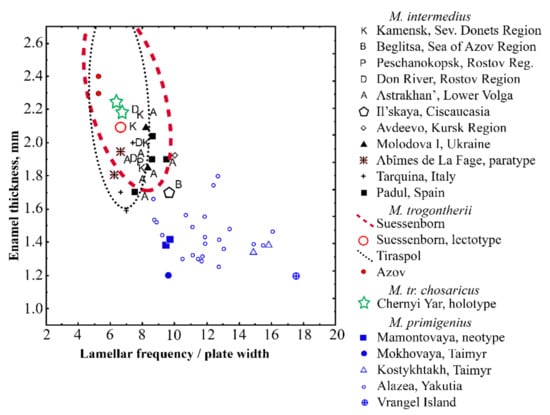
Figure 11.
Ratio of the lamellar frequency/plate width quotient and enamel thickness on the upper M3 of Mammuthus intermedius from the Lower Don Region compared to the other representatives of the genus Mammuthus.
Comparing to the teeth of M. trogontherii chosaricus (Dubrovo, 1966) from the typical localities of the Khazarian faunal complex in Chernyi Yar (the late Middle—early Late Pleistocene), the described finds from the Lower Don Region have a larger number and higher frequency of plates, as well as, on average, thinner and notably less-folded enamel. An analysis of materials from the typical localities of the Lower Volga Region allowed to specify the M3/m3 characteristics of M. trogontherii chosaricus: number of plates (without talons), 19 to 20, lamellar frequency (min–med–max) of 5.5–(6.4)–6.5 and enamel’s thickness of 1.9–(2.15)–2.5 [42].
The studied teeth from the Lower Don Region have a lower number of plates, lower lamellar frequency, greater length of a single plate and thicker enamel compared to the neotype of M. primigenius primigenius (Blumenbach, 1799) from the localities of the second half of the Late Pleistocene from the Taimyr Peninsula [45]. Such differences were observed compared to the typical woolly mammoths—for example, from the localities in Kostykhtakh, Berelyokh, Rodomyshl’ and Alazeya [25,46,47,48]. In the current study, we treated the finds of teeth with a lamellar frequency of 8–13 as belonging to M. primigenius.
The parameters of the described teeth were similar to the ones of M. intermedius from Western Europe and Western Siberia (Figure 9, Figure 10, Figure 11) [15,16,19]. In particular, the mammoths from the late Middle Pleistocene and the early Late Pleistocene localities of the Iberian Peninsula have similar dental characteristics [50]. Similar features are typical of teeth determined as belonging to M. intermedius from the localities of the Khazarian theriocomplex of the Astrakhan Volga Region [18]. A significant similarity to the finds of the mammoth remains from the Mousterian Layer No. 11 of the Molodova V Paleolithic Site (the Dniester Basin) [19] was observed. The teeth of mammoths from the Paleolithic sites of Ilskaya 1 and 2 (the Northern Caucasus [26,51]) and Duruitoarea Veche and Costeşti sites (Republic of Moldova [17,52]) have similar characteristics. Taking into account the materials from the Lower Volga [18] and the Lower Don Regions, we amended the original species’ diagnosis based on the material from France [16]. The main diagnostic dental characteristics of the considered species are a relatively large number of plates (20–26 on M3/m3, without talons), lamellar frequency (min–med–max) of 6.5–(7.6)–8.5 and enamel thickness (min–med–max) of 1.7–(1.92)–2.2.
The variability ranges of the dental metrical characters/characteristics of M. intermedius overlap partially with those of M. trogontherii and M. primigenius. This is typical of “intermediate” taxa, which, in our case, is the considered M. intermedius. The specimens described in the article, as well as other finds attributed to M. intermedius, fall within the lower limits of variability of such parameters as the lamellar frequency and enamel thickness at M. trogontherii (Figure 9 and Figure 10) but differ well from the last one by a larger number of plates. At the same time, M. intermedius differs well from M. primigenius from the Late Pleistocene deposits of the Weichselian period from the north of Eurasia, including the neotype of the latter species, in terms of such parameters as the lamellar frequency and enamel thickness (Figure 9 and Figure 10).
As we noted above, a large number of finds from a rather vast territory of Northern Eurasia and North America and from different landscape zones are often attributed to M. primigenius. Moreover, these remains come from different periods of the late Middle—Late Pleistocene, which often have significantly different environmental conditions. As a result, the diagnosis of M. primigenius is rather indistinct. According to the accepted diagnosis of M. primigenius [53], the number of plates in M3/m3 varies from 20 to 27 (excluding talons/talonids), the lamellar frequency from 7 to 12 on Ml to M3, the enamel thickness from 1 to 2 mm and the ratio of the crown height to the width is 50–150%. It seems that this is a rather large range for intraspecific variability. The separation of the neotype of M. primigenius [54], despite expectations, did not lead to the establishment of an understandable structure of this taxon.
The majority of researchers prefer not to delve into the reason for the existing differences between forms with sufficiently different characteristics. Attempts to single out the subspecies of the woolly mammoth in the mid and late 20th century were not common among researchers. As a result, the M. primigenius may be considered as a “garbage” taxon, to which the researchers attribute all finds of post-trogontherine representatives of Mammuthus. For example, in the graph showing the distribution frequency of the number of plates in M3/m3 of Eurasian Late Pleistocene, M. primigenius lacks a normal distribution (Figure 4D from [55]). The absence of a unimodal distribution in this case indicates the heterogeneity of the sample.
In our opinion, it is impossible to explain the features of mammoths with characteristics similar to those of M. intermedius by the hypothesis associated with the possible hybridization between the earlier and later taxa (in our case, the last trogontherine and the first woolly mammoths). In this case, it is poorly applicable, taken into consideration the rather long period of existence of mammoths with features similar to M. intermedius (MIS7–5). The separation and active use of the M. intermedius taxon with well-understood morphological dental characteristics allows to clarify and specify the mammoths’ evolutionary lineage.
The considered form differs from forest elephants Palaeoloxodon antiquus (Falconer and Cautley, 1847), typical of the Middle and the early Late Pleistocene, by a higher number of plates on the teeth, their higher frequency and the absence of median sinuses on the occlusal surface of enamel plates [36,56,57].
The bones of the postcranial skeleton of M. intermedius from Kamensk-Shakhtinskiy, are, in general, of medium sizes and show intermediate values between those of trogontherine and woolly mammoths. By the general morphology and proportions, the studied bones do not differ from the same bones of the other representatives of the genus Mammuthus.
5. Conclusions
Mammuthus intermedius was typical of the late Middle—early Late Pleistocene (MIS7–5) faunal communities. It was a typical representative of the Khazarian faunal complex in Eastern Europe and, probably, the most widespread and abundant species of mammoths of that period, occupying the steppe biotope. The less-common populations of M. trogontherii chosaricus and P. antiquus most likely inhabited more forested landscapes. M. intermedius was described as from Western Europe. However, the remains of this species are rather common from Eastern Europe as well. Previously, they were described from the territory of the Western Black Sea Region (Moldova [17,52]) and the Lower Volga Region (Russia [18]). The presented study described the remains of M. intermedius from the Lower Don Region, rich in localities of the Middle and the Late Pleistocene. The described material was from a series of localities, related to different types of subaquatic deposits from a vast territory (almost 48.5 thousand km2). All these localities were situated in the zone of open landscapes of steppe and forest-steppe types. The finds are both isolated teeth and parts of several skeletons and, in one case, the remains of a single individual. The teeth characteristics and bone sizes of the postcranial skeleton allowed us to determine the mammoths as belonging to the form intermediate between M. trogontherii and M. primigenius. These mammoths were previously determined as the so-called “early” or “primitive” types/forms of woolly mammoths. However, the resurrection of the species M. intermedius [16] made it possible to systematize the finds and avoid informal taxonomic determinations. The time of appearance of M. primigenius in Continental Europe is considered to be MIS 4 [58]. Considering the materials from the Lower Volga and the Lower Don Regions, we specified the species’ diagnosis based on the material from France. The teeth of this species are characterized by a relatively large number of plates (20–26 on M3/m3, without talons), lamellar frequency (min–med–max) of 6.5–(7.6)–8.5 and enamel thickness of 1.7–(1.92)–2.2. Based on the accompanying fauna and other biostratigraphic data, the age of the finds from the Lower Don Region is determined as the late Middle—early Late Pleistocene. The present paper and study specified the geographical ranges of M. intermedius in Europe.
Author Contributions
Conceptualization, V.S.B.; Methodology, V.S.B.; Validation, V.S.B., V.V.T.; Formal Analysis, V.V.T.; Investigation, V.S.B., V.V.T.; Writing-Original Draft Preparation, V.V.T.; Writing-Review & Editing, V.V.T.; Visualization, V.V.T.; Supervision, V.S.B. All authors have read and agreed to the published version of the manuscript.
Funding
The study was supported by the Russian Science Foundation, Project No. 16-17-10170-P.
Institutional Review Board Statement
Not applicable
Informed Consent Statement
Not applicable
Data Availability Statement
Data is contained within the article and in the collections of mentioned museums.
Acknowledgments
The authors are grateful to the employees of Azov Historical, Archaeological, and Paleontological Museum-Reserve, Aksai Military-Historical Museum, Novocherkassk Museum of History of the Don Cossacks, Rostov Regional Studies Museum, and A.S. Basan for the possibility of working with the collections. The authors are thankful to A.N. Simakova (Geological Institute of the Russian Academy of Sciences, Moscow) for the processing of the palynological samples and useful comments. The authors express their gratitude to R.G. Mikhalyuk for the English language assistance. We are also grateful to the anonymous reviewers for their improvements to the text.
Conflicts of Interest
The authors declare no conflict of interest.
Abbreviations
| AMZ | Azov Historical, Archaeological, and Paleontological Museum-Reserve, Azov, Rostov Region; |
| AVIM | Aksai Military-Historical Museum, Aksai, Rostov Region; |
| NMDC | Novocherkassk Museum of History of the Don Cossacks, Novocherkassk, Rostov Region, Pal—the paleontological division of the collection; |
| PC | private collection of A.S. Basan, Taganrog, Rostov Region; |
| ROMK | Rostov Regional Studies Museum, Rostov-on-Don, Rostov Region; |
| SSC RAS | Southern Scientific Centre of the Russian Academy of Sciences, Rostov-on-Don. |
References
- Lister, A.M. Evolution and taxonomy of Eurasian mammoths. In The Proboscidea. Evolution and Palaeontology of Elephants and Their Relatives; Shoshani, J., Tassy, P., Eds.; Oxford University Press: Oxford, UK; New York, NY, USA; Tokyo, Japan, 1996; pp. 204–213. [Google Scholar]
- Lister, A.M.; Sher, A.V. The origin and evolution of the woolly mammoth. Science 2001, 294, 1094–1097. [Google Scholar] [CrossRef] [PubMed]
- Lister, A.M.; Sher, A.V.; Van Essen, H.; Wei, G. The pattern and process of mammoth evolution in Eurasia. Quat. Int. 2005, 126, 49–64. [Google Scholar] [CrossRef]
- Garutt, V.E. To the history of identifying of the intermediate links in the Archidiskodon–Mammuthus elephants phylogenetic line. In Chronology of the Glacial Age, Materials of Symposium, March 1971, Leningrad, USSR.; Geography Society of the USSR: Leningrad, Russia, 1971; pp. 78–88. [Google Scholar]
- Pavlow, M. Les elephants fossiles de la Russie. Nouv. Mem. Soc. Impér. Nat. Mosc. 1910, 17, 1–56. [Google Scholar]
- Dubrovo, I.A. Systematical position of the elephant of Khozar faunistic complex. Byull. Kom. Izuc. Chetvertichnogo Period. 1966, 32, 63–74. (In Russian) [Google Scholar]
- Garutt, V.E. The origin of elephants and ways of their phylogeny. Trudy Zoologich. Inst. AN SSSR 1986, 149, 15–32. (In Russian) [Google Scholar]
- Dietrich, W.O. Elephas primigenius fraasi, eine schwäbische Mammutraase. Jahresh. Ver. Vaterl. Naturkd. Württemberg 1912, 77, 1–64. [Google Scholar]
- Garutt, V.E.; Averianov, A.O.; Vartanyan, S.L. On the systematic position of the Holocene population of mammoths Mammuthus primigenius (Blumenbach, 1799) from Wrangel Island (Northeast Siberia). Dokl. Akad. Nauk. SSSR 1993, 332, 799–801. (In Russian) [Google Scholar]
- Foronova, I.V.; Zudin, A.N. The structure of the lineage Archidiskodon-Mammuthus in Eurasia and peculiarities of its evolution. Deinsea 1999, 6, 103–118. [Google Scholar]
- Foronova, I.V. Quaternary Mammals of the South-East of Western Siberia (Kuznetsk Basin): Phylogeny, Biostratigraphy, and Palaeoecology; Publishing House of Siberian Branch, Russian Academy of Sciences: Novosibirsk, Russia, 2001; 243p, ISBN 5-7692-0411-7. (In Russian) [Google Scholar]
- Foronova, I.V. Thin-enamel dental specialization in mammoth evolution: An example of direction selection. Quat. Int. 2007, 169, 95–104. [Google Scholar] [CrossRef]
- Jourdan, C. Des terrains sidérolitiques. CR Acad. Sci. 1861, 53, 1009–1014. [Google Scholar]
- Lortet, L.; Chantre, E. Études paléontologiques dans le Bassin du Rhône: Période quaternaire. Arch. Mus. Hist. Nat. 1872, 1, 59–130. [Google Scholar]
- Beden, M.; Guérin, C. Les Proboscidiens du gisement pléistocène moyen des Abîmes de La Fage à Noailles (Corrèze). Nouv. Arch. Mus. Hist. Nat. 1975, 13, 69–87. [Google Scholar]
- Labe, B.; Guérin, C. Réhabilitation de Mammuthus intermedius (Jourdan, 1861), un mammouth (Mammalia, Elephantidae) du Pléistocène moyen récent d’Europe. CR Palevol. 2005, 4, 235–242. [Google Scholar] [CrossRef]
- Obadă, T. Evidence of contact between Mammuthus intermedius (Jourdan, 1861) and ancient humans from Duruitoarea Veche, Republic of Moldova: Preliminary data. In Abstracts of VIth International Conference on Mammoths and their Relatives; Spec. Vol. 102; S.A.S.G.: Thessaloniki, Greece, 2014; pp. 145–146. [Google Scholar]
- Golovachev, M.V.; Titov, V.V. Remains of Mammuthus intermedius Jourdan, 1861 from the type localities of the Khazar fauna of the Lower Volga Region. Trudy Zoologich. Inst. RAN 2018, 322, 268–284. (In Russian) [Google Scholar] [CrossRef][Green Version]
- Foronova, I.V. Mammoths of the Molodova V Paleolithic site (Dniester Basin): The case of dental thin-enamel specialization and paleoecological adaptation. Quat. Int. 2014, 326, 235–242. [Google Scholar] [CrossRef]
- Baigusheva, V.S. Mammoth Mammuthus primigenius Blum. from the left bank of Severskiy Donets River. Trudy Zoologich. Inst. AN SSSR 1980, 93, 75–80. (In Russian) [Google Scholar]
- Baigusheva, V.S. About some palaeontological finds from the collections of the Museum of Don Cossacks history. Kraevedcheskie Zapiski 1999, 4, 94–115. (In Russian) [Google Scholar]
- Averianov, A.O.; Baryshnikov, G.F.; Garutt, V.E.; Garutt, N.V.; Fomicheva, N.L. The Volga Fauna of Pleistocene Mammals in the Geological and Mineralogical Museum of Kazan University; Kazan University Publishes: Kazan, Russia, 1992; 164p. (In Russian) [Google Scholar]
- Kazanov, I.A.; Titov, V.V. About the find of mammoth in the Belaya Kalitva district of Rostov Region. In Basic Problems of Quaternary, Research Results, and the Main Trends of Future Studies. Proceedings of VIII All-Russian Conference on Quaternary Research, Rostov-on-Don, Russia, 10–15 June 2013; SSC RAS Publishers: Rostov-on-Don, Russia, 2013; pp. 259–260. (In Russian) [Google Scholar]
- Zastrozhnov, A.S.; Danukalova, G.A.; Golovachev, M.V.; Titov, V.V.; Tesakov, A.S.; Simakova, A.N.; Osipova, E.M.; Trofimova, S.S.; Zynoviev, E.V.; Kurmanov, R.G. Singil Deposits in the Quaternary Scheme of the Lower Volga Region: New Data. Stratigr. Geol. Correl. 2018, 26, 647–685. [Google Scholar] [CrossRef]
- Korniets, N.L. About the reasons of mammoth’s extinction at the territory of Ukraine. In Fossil Faunae of Ukraine and Adjacent Territories; Pidoplichko, I.G., Ed.; Naukova Dumka: Kiew, USSR, 1962; pp. 93–169. (In Ukranian) [Google Scholar]
- Baryshnikov, G. Mammuthus primigenius from the Crimea and the Caucasus. Deinsea 2003, 9, 41–56. [Google Scholar]
- Zamyatnin, S.N. Notes about the Palaeolithic of the Donets Basin and Sea of Azov Region. Sbornik Muzeya Antropol. Etnographii 1953, 14, 231–255. (In Russian) [Google Scholar]
- Velichko, A.A.; Morozova, T.D.; Borisova, O.K.; Timireva, S.N.; Semenov, V.V.; Kononov, Y.M.; Titov, V.V.; Tesakov, A.S.; Konstantinov, E.A.; Kurbanov, R.N. Development of the steppe zone in Southern Russia based on the reconstruction from the loess-soil formation in the Don–Azov Region. Dokl. Earth Sci. 2012, 445, 999–1002. [Google Scholar] [CrossRef]
- Velichko, A.A.; Borisova, O.K.; Kononov, Y.M.; Konstantinov, E.A.; Kurbanov, R.N.; Morozova, T.D.; Panin, P.G.; Semenov, V.V.; Tesakov, A.S.; Timireva, S.N.; et al. Reconstruction of Late Pleistocene Events in the Periglacial Area in the Southern Part of the East European Plain. Dokl. Earth Sci. 2017, 475, 895–899. [Google Scholar] [CrossRef]
- Tesakov, A.S.; Titov, V.V.; Leonova, N.B.; Velichko, A.A.; Simakova, A.N.; Zastrozhnov, A.S.; Frolov, P.D. Quaternary Stratigraphy and Paleontology of the Southern Russia: Connections between Europe, Africa, and Asia. Programme and Guidebook of Excursions of 2010 Annual Meeting INQUA-SEQS, Rostov-on-Don, Russia, June 21–26 2010; SSC RAS Publishers: Rostov-on-Don, Russia, 2010; 48p. [Google Scholar]
- Tesakov, A.S.; Titov, V.V.; Baygusheva, V.S.; Velichko, A.A.; Timireva, S.N.; Simakova, A.N.; Borisova, O.K.; Morozova, T.D.; Semenov, V.V.; Syromyatnikova, E.V.; et al. Basic Problems of Quaternary, Research Results, and the Main Trends of Future Studies. VIII All-Russian Conference on Quaternary Research: Field Excursions Guidebook, Rostov-on-Don, Russia, 10–15 June 2013; SSC RAS Publishers: Rostov-on-Don, Russia, 2013; 48p. (In Russian) [Google Scholar]
- Byakov, A.S.; Parada, S.G.; Lev, I.E. The rare find of late Pleistocene mammoth at the south of Russia (Rostov Region). In Proceedings of the II Intern. Conference, Volume 1, Novocherkassk, Russia, 21–23 October 1999; pp. 97–98. (In Russian). [Google Scholar]
- Baygusheva, V.S.; Titov, V.V.; Tesakov, A.S.; Syromyatnikova, E.V.; Kurshakov, S.V.; Frolov, P.D. Middle Pleistocene fauna of Veshenskaya (middle Don River, Rostov Region, Russia). In The Quaternary of the Urals: Global trends and Pan-European Quaternary Records. Abstract Book of Intern. Conf., Ekaterinburg, Russia, 10–16 February 2014; UrFU Publishers: Ekaterinburg, Russia, 2014; pp. 15–17. [Google Scholar]
- Dodonov, A.E.; Tesakov, A.S.; Titov, V.V.; Inozemtcev, S.A.; Simakova, A.N.; Nikolskiy, P.A.; Trubikhin, V.M. New data on stratigraphy of Pliocene-Pleistocene deposits of lower Don River, cross sections of Tsimliansk reservoir. In Geological Events of Neogene and Quaternary of Russia: Recent Condition of Stratigraphical Schemes and Palaeogeographical Reconstructions. Proceedings of All-Russian Conference; GEOS: Moscow, Russia, 2007; pp. 43–53. (In Russian) [Google Scholar]
- Titov, V.V. Habitat conditions for Camelus knoblochi and factors in its extinction. Quat. Int. 2008, 179, 120–125. [Google Scholar] [CrossRef]
- Dubrovo, I.A. Ancient elephants of the SSSR. Trudy Paleontologich. Inst. AN SSSR 1960, 85, 78. (In Russian) [Google Scholar]
- Aguirre, E. Evolutionary history of the elephant. Science 1969, 164, 1366–1376. [Google Scholar] [CrossRef]
- Garutt, V.E.; Foronova, I.V. Research on the Teeth of Extant Elephants: Methodological Recommendations; Institute of Geology and Geophysics Publishers: Novosibirsk, Russia, 1976; p. 36. (In Russian) [Google Scholar]
- Janis, C.M. An Estimation of Tooth Volume and Hypsodonty Indices in Ungulate Mammals, and the Correlation of these Factors with Dietary Preference. Mem. Mus. Nat. Hist. Nat. Paris Ser. C 1988, 53, 367–387. [Google Scholar]
- Sher, A.V.; Garutt, V.E. New data on morphology of elephants’ molars. Dokl. Akad. Nauk. SSSR 1985, 285, 221–225. (In Russian) [Google Scholar]
- Dubrovo, I.A. Mammuthus trogontherii trogontherii (Pohlig) aus dem Pleistozän von Tiraspol. Quartärpaläontologie 1975, 1, 125–155. [Google Scholar]
- Titov, V.V.; Golovachev, M.V. The skeleton of mammoth Mammuthus trogontherii cf. chosaricus Dubrovo, 1966 from terminal Middle Pleistocene of the Lower Volga region (Russia). Russian J. Theriol. 2017, 16, 15–29. [Google Scholar] [CrossRef]
- Osborn, H.F. Proboscidea. A Monograph of the Discovery, Evolution, Migration and Extinction of the Mastodonts and Elephants of the World, Vol. II. Stegodontoidea Elaphantoidea; American Museum Press: New York, NY, USA, 1942; 828p. [Google Scholar]
- Kahlke, R.D. Zur festlegung des lectotypus von Mammuthus trogontherii (Pohlig, 1885) (Mammalia, Proboscidea). Quartärpaläontologie 1990, 8, 119–124. [Google Scholar]
- Averianov, A.O. Kutomanov’s Mammoth. Trudy Zoologich. Inst. AN SSSR. 1994, 256, 111–135. (In Russian) [Google Scholar]
- Vereshchagin, N.K. Berelekhskoe “cemetery” of mammoth. Trudy Zoologich. Inst. AN SSSR 1977, 72, 5–50. (In Russian) [Google Scholar]
- Maschenko, E.N.; Gablina, S.S.; Tesakov, A.S.; Simakova, A.N. The Sevsk woolly mammoth (Mammuthus primigenius) site in Russia: Taphonomic, biological and behavioral interpretations. Quat. Int. 2006, 142, 147–165. [Google Scholar] [CrossRef]
- Kirillova, I.V.; Shidlovskiy, F.K.; Titov, V.V. Kastykhtakh mammoth from Taimyr (Russia). Quat. Int. 2012, 276, 269–277. [Google Scholar] [CrossRef]
- Kirillova, I.V.; Borisova, O.K.; Chernova, O.F.; Van Kolfschoten, T.; van der Lubbe, J.J.L.; Panin, A.V.; Pečnerová, P.; van der Plicht, J.; Shidlovskiy, F.K.; Titov, V.V.; et al. ‘Semi-dwarf’ woolly mammoths from the East Siberian Sea coast, continental Russia. Boreas 2020, 49, 269–285. [Google Scholar] [CrossRef]
- Álvarez-Lao, D.J.; García, N. Comparative revision of the Iberian woolly mammoth (Mammuthus primigenius) record into a European context. Quat. Sci. Rev. 2012, 32, 64–74. [Google Scholar] [CrossRef]
- Hoffecker, J.F.; Baryshnikov, G.; Potapova, O. Vertebrate Remains from the Mousterian Site of Il’skaya I (Northern Caucasus, U.S.S.R.): New Analysis and Interpretation. J. Archaeol. Sci. 1991, 18, 113–147. [Google Scholar] [CrossRef]
- Obadă, T.; Ivanov, S.; Kolavenko, S.; Paşenciuc, N. New findings from the Paleolithic site of Costesti I in the north-western Moldova. Bul. Ştiinţ. Rev. Etnogr. Ştiinţ. Naturii Muzeol. (Ser. Nouă) 2018, 28, 44–54. [Google Scholar]
- Maglio, V.J. Origin and evolution of the Elephantidae. Trans. Am. Philos. Soc. 1973, 63, 149. [Google Scholar] [CrossRef]
- Garutt, V.E.; Gentry, A.; Lister, A.M. Mammuthus Brookes, 1828 (Mammalia, Proboscidea): Proposed conservation, and Elephas primigenius Blumenbach, 1799 (currently Mammuthus primigenius): Proposed designation as the type species of Mammuthus, and designation of a neotype. Bull. Zoolog. Nomencl. 1990, 47, 38–44. [Google Scholar] [CrossRef]
- Lister, A.M.; Sher, A.V. Evolution and dispersal of mammoths across the Northern Hemisphere. Science 2015, 350, 805–809. [Google Scholar] [CrossRef]
- Palombo, M.R.; Ferretti, M.P. Elephant fossil record from Italy: Knowledge, problems, and perspectives. Quat. Int. 2005, 126, 107–136. [Google Scholar] [CrossRef]
- Baygusheva, V.S.; Titov, V.V. Palaeoloxodon elephant from the Sea of Azov Region (Russia). In Abstr. 6th Meeting of the European Association of Vertebrate Palaeontologists. Slovakia, 30 June–5 July 2008; Spišská Nová: Ves, Slovakia, 2008; pp. 12–14. [Google Scholar]
- Puzachenko, A.Y.; Titov, V.V.; Kosintsev, P.A. Evolution of the European regional large mammals assemblages in the end of the Middle Pleistocene—The first half of the Late Pleistocene (MIS 6–MIS 4). Quat. Int. 2021. [Google Scholar] [CrossRef]
Publisher’s Note: MDPI stays neutral with regard to jurisdictional claims in published maps and institutional affiliations. |
© 2021 by the authors. Licensee MDPI, Basel, Switzerland. This article is an open access article distributed under the terms and conditions of the Creative Commons Attribution (CC BY) license (http://creativecommons.org/licenses/by/4.0/).